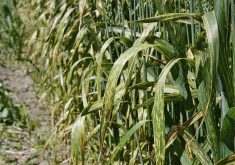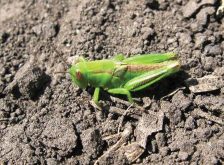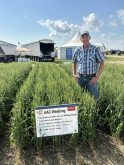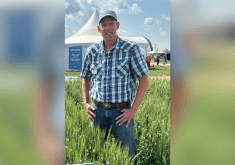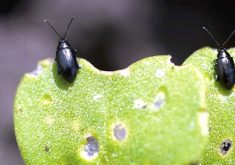Last summer’s drought and brutal heat was a game changer for insect pests across the Prairies.
Some got knocked back, others managed just fine and many acted in new ways as they tried to adapt.
“Every pest species we deal with could be responding to these hot and dry conditions differently,” said Meghan Vankosky, a research scientist with Agriculture and Agri-Food Canada in Saskatoon.
“Temperature and precipitation act in different ways and have different potential impacts. And then you throw in the natural enemies and that can add a wrinkle as well.
Read Also

Mosquito-borne virus could be devastating to sheep breeding operations
Cache Valley virus, a mosquito-borne disease that infects small ruminants, could be a devastating hit to small operations.
“Some natural enemies do better if it is wetter, and others, like the parasitoids, might follow the same pattern as the host, and they might be negatively or positively affected by those changes.”
The phenology — how living organisms respond to changing climatic conditions — was strange for many insects because the temperatures in July were extremely hot for so long.
Grasshoppers like hot and dry weather, and warmer temperatures cause them to develop faster and lay eggs faster. So they could lay more eggs before things cool off.
“They can develop more before the winter comes, which means they can develop faster in the spring,” said Vankosky.
And that has implications for this coming growing season.
“We will see those grasshoppers come out earlier in the spring because the eggs will be hatching earlier. And then of course, the fungal pathogens are generally less effective if it is hot and dry. They like cool and wet conditions.”
Their population growth will be more pronounced in areas that are already prone to grasshoppers, such as southern Alberta. But there’s a time delay.
“We’re trending towards outbreak years, but it is still building up,” she said.
The good and the bad
The other species to worry about is the wheat stem sawfly, which also tends to do well in drought conditions.
“The big driver there is that the parasitoid of the wheat stem sawfly can generally only manage one generation if it’s really hot, because the host develops too fast,” she said.
And having only one generation of the parasitoid means there’s less natural control for wheat stem sawfly.
According to the province’s wheat stem sawfly forecast map, there were increasing populations in southern Alberta, especially in counties along the U.S. border, and so the pest could be a significant problem this year, said Vankosky.
But other villains could be knocked back.
“In terms of insects that don’t respond well to drought, wheat midge is one of the big ones that we’ve been talking about,” she said. “They need that moisture early in the growing season to finish their development. If the wheat midge doesn’t emerge at the right time, then their hosts aren’t going to be there at the right time for them to lay eggs.”
The outlook for cabbage seedpod weevils is up in the air.
Models (based on both the insect’s biology and past monitoring) suggest they will move north if dry conditions persist but “we don’t know what is driving their response” to heat and drought, said Vankosky.
“One of the things that I think could be having an effect is that if it’s dry, then the larvae that are moving into the soil could desiccate or not survive,” she said.
That same fate could also await pea leaf weevil.
“Their larval stage develops completely in the soil. They pupate in the soil. If the soil is dry and very hard, then it could be difficult for the new adults to climb back out of the soil or dig their way out. Having that lifestyle in the soil could be having some really negative effects on those populations.”
Striped and crucifer flea beetles vary in their reaction to heat.
The striped beetles like it to be cooler and wetter, so their populations could expand farther north. Crucifer flea beetles tend to do better when it is hot and drier and are often more prevalent in the south.
“They certainly overlap, but that’s the general trend,” she said.
Although she doesn’t have a crystal ball, Vankosky has some words of wisdom for growers as they plan for the upcoming growing season.
“I think it’s good to have grasshoppers on the mind and be prepared to scout for them early in the season,” she said. “It’s easiest to kill a grasshopper when they are small, compared to when they are big.”
That means getting out to scout a bit earlier, and if conditions are favourable, look for wheat midge, too.
“If it rains early in the season, be prepared to scout for wheat midge.”




